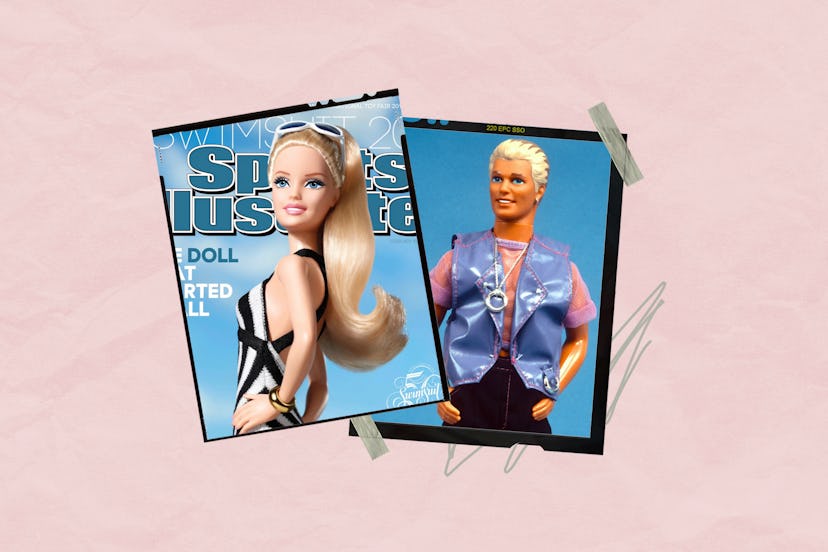Nostalgia
The Most Controversial Barbie & Ken Dolls In History
Including a Girl Scout, a Sports Illustrated model, and a “gay Ken.”

The release of Greta Gerwig’s Barbie has sparked a wave of renewed interest in the iconic, titular doll. First released in 1959 at a New York Toy Fair, Barbie was created by Ruth Handler as an alternative to the mom and housewife-themed dolls that dominated the market at the time. The industry was less than enthusiastic about Barbie upon her debut, and experts doubted the doll would enjoy any long-term success — but Handler proved them all wrong.
Barbie — and her male equivalent, Ken — remain cultural phenomenons to this day, with Mattel having sold more than a billion dolls in a variety of iterations throughout the plastic couple’s 64-year history. However, even Barbie Land is not without its controversies, and Mattel has endured a string of Barbie-centric scandals over the years, facing accusations of sexism, promoting an unrealistic body image, and more.
Discover some of the most controversial Barbie and Ken dolls ever made, below.
1
Barbie Loves Girl Scouts
The Mattel and Girl Scouts partnership drew criticism from advocacy groups in 2013, with organizations such as the Commercial-Free Childhood accusing the doll of sexualizing young girls and undermining “the Girl Scouts’ vital mission to build ‘girls of courage, confidence, and character.”
The Girl Scouts rejected these concerns, however, claiming their Barbie partnership “teaches girls about inspiring women in a fun way.” Mattel's Barbie Loves Girl Scouts doll eventually hit the shelves in 2014, dressed in a pink and green Girl Scouts uniform and high-heel hiking boots — along with the first corporate-sponsored Girl Scouts uniform patch ever made.
2
Earring Magic Ken
Earring Magic Ken — styled with a mesh lavender top, pleather vest, and bleach-blonde highlights — was billed as a “cooler” take on Barbie’s male counterpart. The 1992 doll caught the attention of many in the LGBTQ+ community at the time, including writer and activist Dan Savage. With this striking new look, “Ken comes out,” Savage declared, drawing particular attention to the doll’s circular-shaped necklace, which resembled a sex toy popular among gay men.
Mattel was not pleased. Earring Magic Ken was discontinued after only six months and appears to have been scrubbed from the Barbie archive, despite reportedly being one of the best-selling Ken dolls of all time.
3
Sports Illustrated Barbie
Mattel faced a wave of backlash when it announced that Barbie would grace the cover of Sports Illustrated’s 2014 swimsuit edition. Critics claimed the partnership equated to little more than “dehumanizing” and “objectifying” women as inanimate objects.
However, Mattel stood by the doll, hailing Barbie as the embodiment of the Sports Illustrated theme of that year: “Legends.” “Posing in SI gives Barbie and her fellow legends an opportunity to own who they are and celebrate what they have accomplished,” a Mattel spokesperson said at the time.
4
Teen Talk Barbie
With the ability to voice pre-programmed phrases at the press of a button, the 1992 Teen Talk Barbie doll flew off the shelves in the early ‘90s. But not everyone was a fan: This iteration of the iconic doll was criticized by the American Association of University Women, thanks to one regrettable phrase in particular: “Math class is tough!”
Mattel later removed the phrase from Barbie’s lexicon, admitting that the company didn't fully consider its “potentially negative implications.”
5
Tattooed Barbie
To mark Barbie’s 50th birthday, Mattel unveiled the Totally Stylin' Tattoos doll in 2009, packaged with a plastic tattoo gun and tattoo stickers. Some parents were alarmed — as one concerned mother told CBS News at the time, “I think it sends all the wrong signals for young girls.” But Mattel wasn’t deterred, and went on to release another tatted Barbie in 2010, in collaboration with the fashion brand Tokidoki.
6Slumber Party Barbie
When Slumber Party Barbie first debuted in the mid-1960s, the doll came with a satin pajama set, pink heels, hair curlers, and a tiny hand mirror. It also was packaged with some more controversial accessories — namely, a pink bathroom scale (that was permanently set to 110 lbs) and a diet book that in part read, “Don’t eat!” It’s easy to see why the set raised eyebrows.
The doll was promptly rebranded as the Barbie Sleepytime Gal, and the pink scale was dropped from the set. A more recent version of the doll in question, named Barbie Pajama Doll, did away with the controversial accessories in favor of a reading lamp and a mug of hot chocolate.
7
Video Girl Barbie
Although marketed to “budding filmmakers,” the 2010 Video Girl Barbie prompted the FBI to issue a stark warning about some of the doll’s features. Specifically, there was concern about the Barbie’s built-in camera and video screen, which could capture up to 30 minutes of footage and be downloaded to a computer — a feature officials believed could lead to potentially sinister consequences online.
8
Computer Engineer Barbie
The Mattel book Barbie: I Can Be A Computer Engineer, which follows the iconic doll as she sets out to be a computer programmer, hit the shelves in 2010. In the book, Barbie relies on the help of her male friends, leading to accusations of sexism from readers — some of whom reimagined the story online under the name Feminist Hacker Barbie.
Mattel later apologized for the book, saying it “doesn’t reflect the Brand's vision for what Barbie stands for.”
This article was originally published on